


TABLE OF CONTENT
1/ INTRODUCTION TO THE BRAND
2/ THE PRADA GROUP
3/ SUSTAINABILITY JOURNEY
4/ SUSTAINABILITY DEVELOPMENT
5/ FOR PLANET
6/ FOR PEOPLE
6/ FOR CULTURE
CONCLUSION BIBLIOGRAPY
A G E
TH E H E R I




1/ INTRODUCTION TO THE BRAND
2/ THE PRADA GROUP
3/ SUSTAINABILITY JOURNEY
4/ SUSTAINABILITY DEVELOPMENT
5/ FOR PLANET
6/ FOR PEOPLE
6/ FOR CULTURE
A G E
TH E H E R I
The Italian luxury fashion house, Prada, as we know it today, is the result of the gamechanging conception that Miuccia Prada, the former creative mastermind, has about fashion and luxury. She took over the wheel in 1978 of what was until then a smaller scaled family luxury goods business. This business was founded in 1913 by the bothers Mario and Martino Prada, calling luxury store business 'Fratelli Prada'. Today, Prada belongs to the Prada Group and is worth over $11 billion.



Miuccia Bianchi Prada was born in 1949, as heir of the Prada imperial. However, while obtaining a doctorate in political sciences, being a member of the Italian communist party and an active feminist, advocating for woman's liberty, she didn't see herself starting a (blooming) career in fashion. She ends up creating her first collections of luggage and footwear anyway, which didn't stick with the customers. During this time, she crosses paths with a young leather goods maker and fashion entrepreneur, Patrizio Bertelli. He advices her to go into making clothing besides the leather goods. This teamwork ended up in a flourishing marriage and business, combinging Miuccia's creative spirit and Patrizio's sense for business.
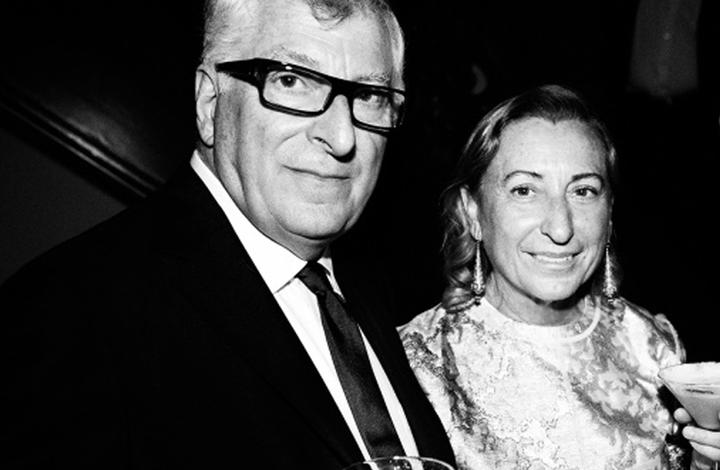
In 1998, Prada's first ready-towear collection was a complete transformation of the brand, as she brought with her, her innovative and subversive ideas. Her style which is now the style linked to Prada, will soon after get the name 'Ugly Chic'. Since the first designs, every season has been different, but the key elements are the clothes designed for working woman, inspired by masculine silhouettes. She will always want to differ from the traditional luxury, by putting forward the utilitarian and wearable side of clothing and accessories.

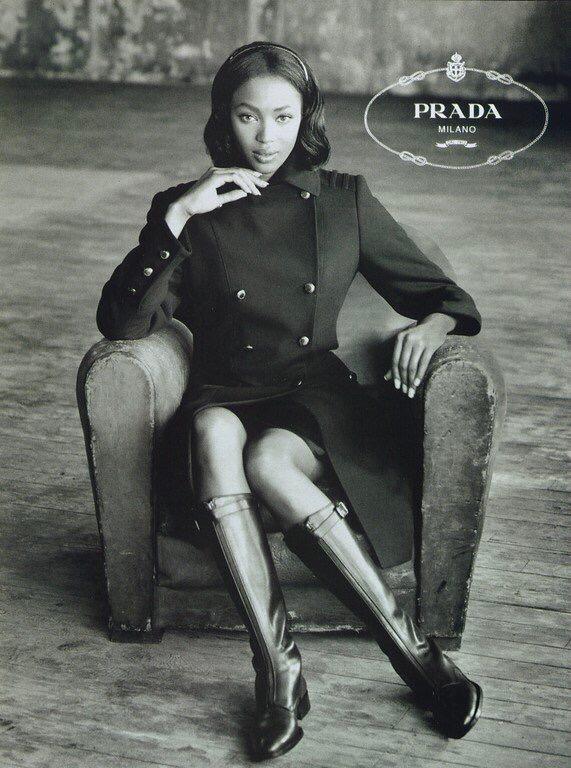

Prada is a brand that unlike other brands, never follows the trends, instead, they create their own. When the season is all about minimalism, Miuccia Prada will fill the catwalk with curved lines and popping colours.
Something that is very clear when analysing the Prada-sphere is that the brand spirit is build on 'coincidenta oppositrium' which is a term for the nonrational union of opposites. Every collection is different, some like Muiccia's first ever collection are all about simplicity. Others are the total oppostie and show very complex designs. The term also references to the believe that every men and woman have a masculine and feminine side. This idea intrigues Muiccia Prada a lot and so a lot of her designs for woman, are based on the traditional masculine silhouette. Same works for the mens-collections.
In other words, the traditional ideas are being transformed, to something that's completely new, implementing a more profound way of thinking.
A first examples of this philosophy is Miuccia Prada's first popular collection for her Italian fashion house. She designed a range of backpacks and purses, now know as the 'Vela' bags, made from pocone, a waterproof nylon. For this collection, already focusing more on the ulitarian side than the fashionable one, she got inspired by her grandfathers past in the army, where they used to make parachutes from nylon. Until this day, Pocone would become a fabric associated with the brand.
Muiccia Prada showed her creative powers and launched a womans collection in 2011, showing of a very unique banana print. Which is a refference to the brands disruptive innovation.
In an interview she explains, she wasn't sure it would be loved by the public, but she quickly adds a wise set of words: 'when being unsure, this is when you should most definetly put it out there'.
A third inconic product that is now part of Prada's brand image, are the never seen before Flame Heels. This bold pair of heels, appeared everywhere ever since on the fashion scene, in multiple flaming hot colours.
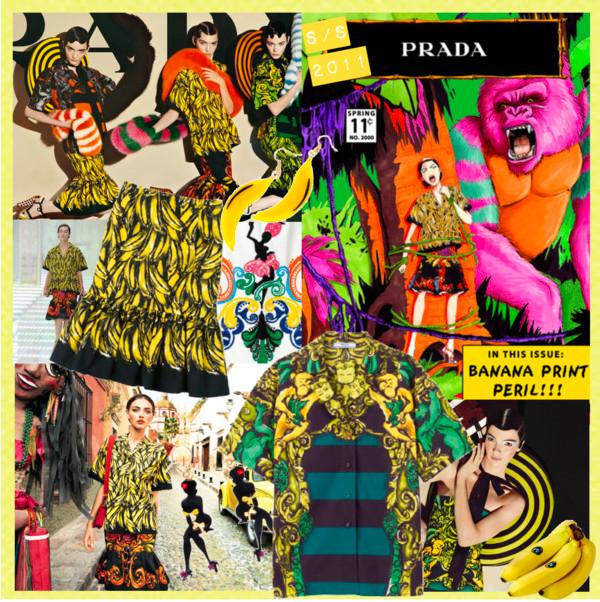




The last but one of the most vital elements of Prada's brand DNA is the logo. It's are an Italian luxury fashion house, with at the base of everything, very qualitative leather goods.
As seen before in history, their goods very much appreciated by the wealthy and so they became the official supplier of the Italian Royal House in 1919.

The business was given permission to incorporate House of Savoy emblem in the company logo as a result of the royal family's sponsorship. Two specifics a rope and a coat of arms—have been chosen as the trademark's specifications.
The Prada brothers added their last name along with them. This enabled the business in surviving and resisting competitive pressure as well as gaining notoriety.
The official logo changes are not static. For instance, the logo is frequently used on bags as a triangle-shaped patch plate that displays a small coat of arms and a figured ribbon. Some branded products have "Prada Milano" or "Prada" written on the label.
Miuccia Prada's love for simplicity and novelty, can be found the significance of the logo that expresses the great significance of the Fashion House through minimalist design. The official sign that declares "anti-status" in opposition to snobbery does not register with Prada because of its elaborate and excessive elements. As a result, only tiny fasteners, buckles, tags, and labels bear the name. B R A N DI M A G E & D N A

As the Prada power couple Fabrizio and Miuccia get a bit older, they start thinking about the future of their lifework. On the one hand there's of course their eye apple ,Lorenzo Bertelli, who is currently one of the executive directors of the brand. Before that he fulfilled the role as head of CSR since 2017. As the future CEO of Prada he has a well stated view. Taking Prada into the next decades, he wants to focus on its sustainable growth. That means engaging themselves in the debate over inclusion and diversity, a partnership with UNESCO, signing of the Fashion Pact and Study how to use materials resulting from alternate methods and resources.
Another person that will guide Prada into the future is the notorious Belgian designer and co-creative director: Raf Simons. As the CEO of Prada Group Patrizio Bertelli explained about the liaison between Raf and Miuccia «Not just a professional, but a human relationship. They share a similar identity». Contrasting relationships in the creative approach to clothing are rooted in creative partnerships. Following the release of their debut collection, Miuccia Prada and Raf Simons revisited the brand's history by moving away from gendered clothing and focusing instead on vivid prints and tailored suits, which changed the way they used their core language—the portrayal of an unrestricted body.
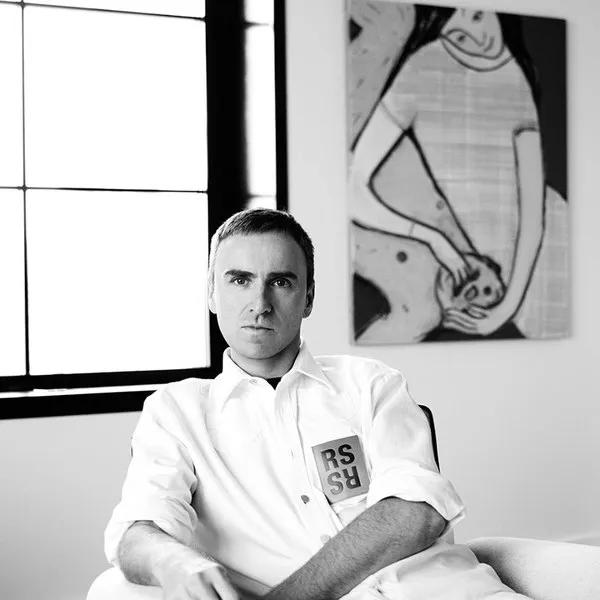
As the Prada brand in the 1970s consolidates their production recourses and other activities with Tuscan entrepreneur Fabrizio Bertelli, gradually the Prada Group gets shaped. In the 1990's, the more younger targeting brand called Miu Miu sees the light of day. This would be the beginning of expansion of the Group towards the production and distribution of luxury handbags, leather goods, footwear, apparel and accessories. These segments fall under the brand names like Church, Car Shoe and Luna Rossa. They also stepped foot in the fragrance-, eyewear- and after the licensing agreement with the Italian eyewear manufacturer Luxottica and acquisition of Pasticceria Marchesi 1824, the gastronomy market. The Prada Group had at 31st December 202
€3.4 Billion in revenues
70 countries
635 Directly Operated Stores
23 Industrial facilities
217 million investments.

The Group sees their brands succes as a result of the business model, which supports on the combination of skilled craftsmanship together with industrial manufacturing process, discipline, tradition and technological progress. Moreover, they get to integrate innovative fashion concepts into their final products, through the remain full control of their know-how, quality, production costs and sustainability standarts. This aligns with their idea of fashion reflecting on the very dynamic society. Besides craftsmanship, creativity and the willingness to push boundaries play another big role within Prada. This led to a nomination of Miuccia Prada with 'Fashion Award 2020 for creativity' by the British Fashion Council.

Perceptibly the groups distribution strategy grew out to a omnichannel one, fully consistent with the brands image, heritage and exclusivity. Direct customercontact is ensured with the ecommerce site and physical retail, offering a constant evolving shopping experience. This goes also for online retail and wholesale channel. As of 31st december 2021, 88% of the Prada Group's sales stems from retail, the other 12% were gained through the wholesale channel. The integrated customer centric approach stands for elaborating on the real-time personalised experiences, through cutting edge operating and technology like Artificial Intelligence. Enhancing Prada Group's story telling across physical, digital and parallel worlds and ecosystems.
06
Prada Group's overarching goal is to create long-lasting sustainable and balanced value. Diversity is an essential element in obtaining this. Within the 7 boards and committees, there's the 'Sustainability Committee', that assists the main Board of Directors in sustainabilityrelated decision making. Additionally the group has a Corporate Social Responsibility Department (CSR) who ties this committee in the company's most operational applications. Both entities are responsible for the whole Sustainability management; CSR and EMS incorporation, risk management, preparing the final reports, etc. Internal communication and training about these matters is put in place as well.
As part of the long-term CSR commitments, various departments and external specialist were given the task to implement thorough risk management. The main components are:
Control environment: efficiency & reliability
Risk assessment: minimising risks
Control activities: internal working group
Information and communication: electronic internal communication channel/ whistleblowing platform Control system


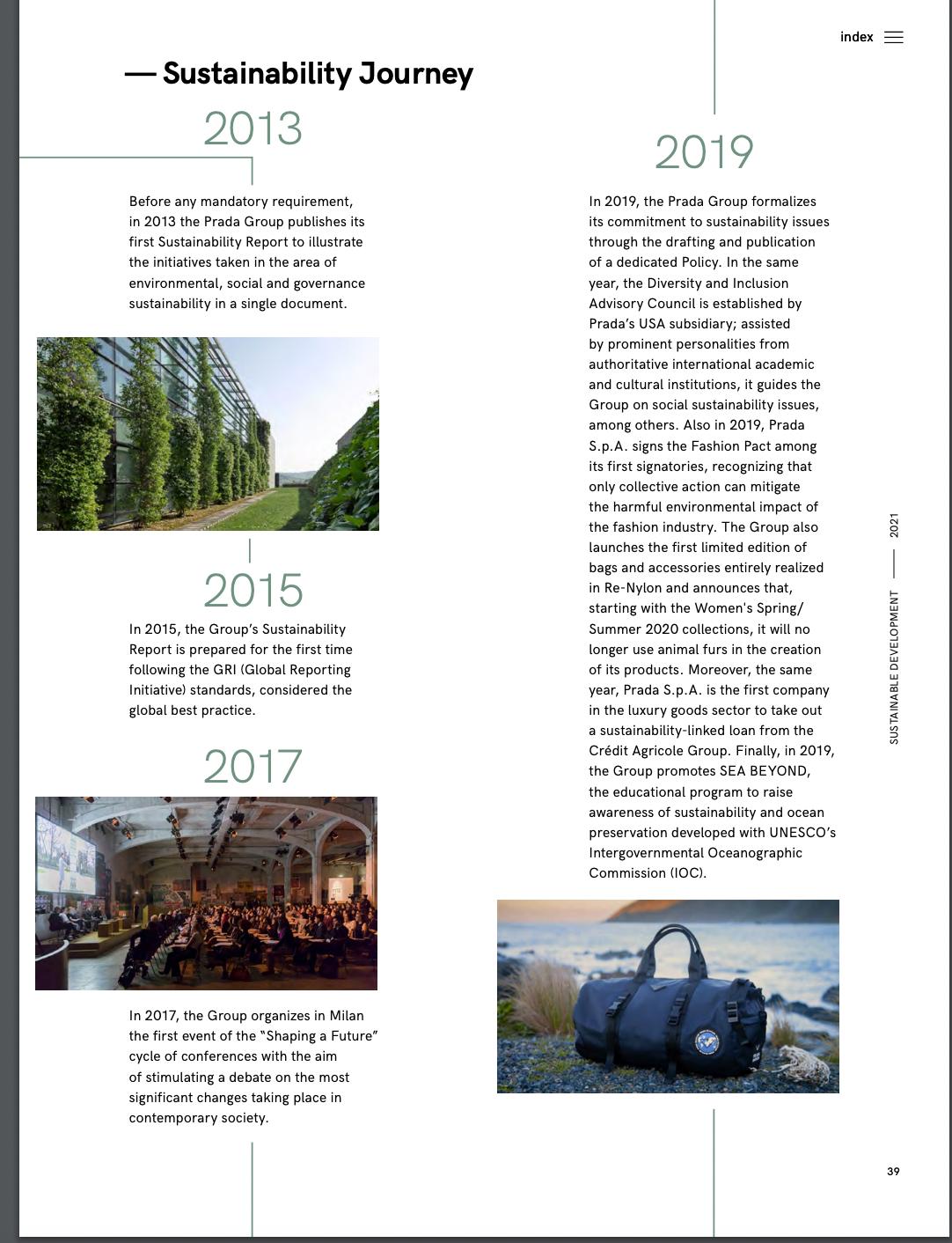

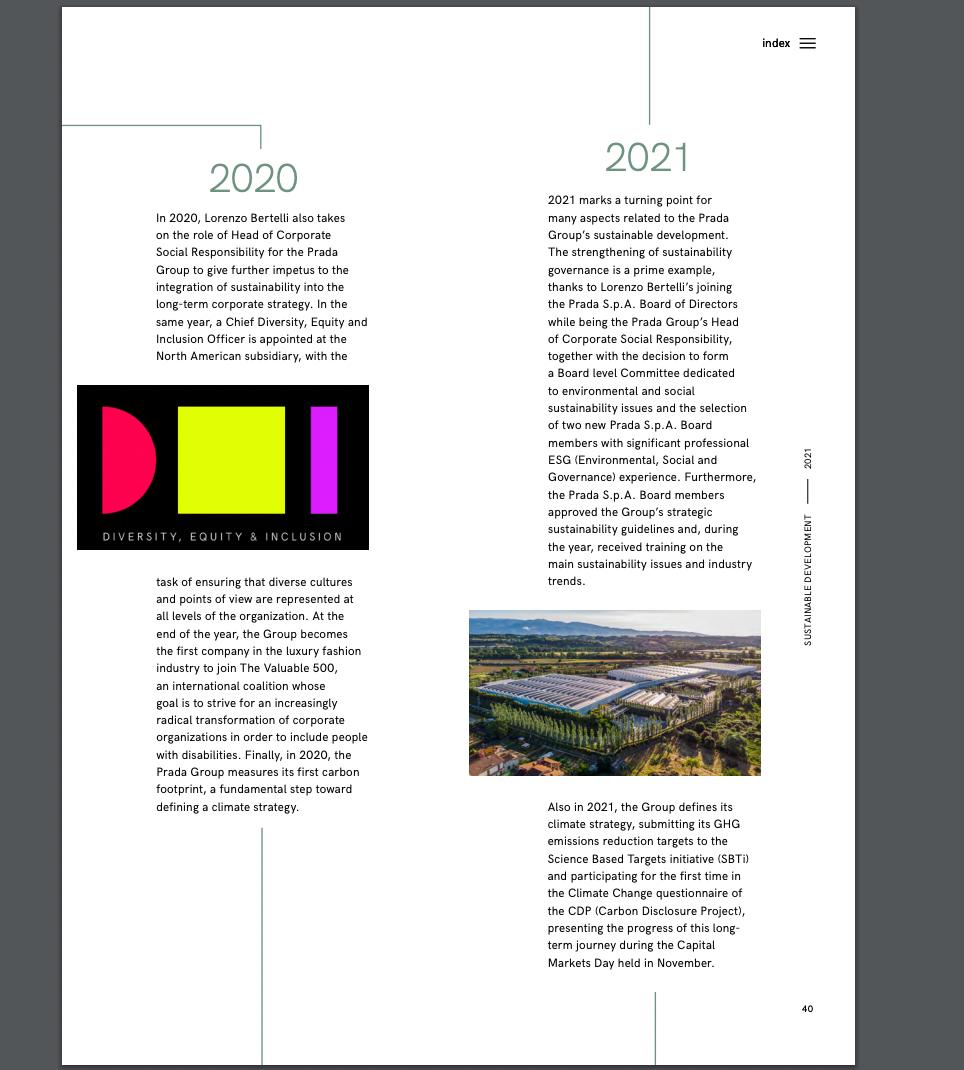

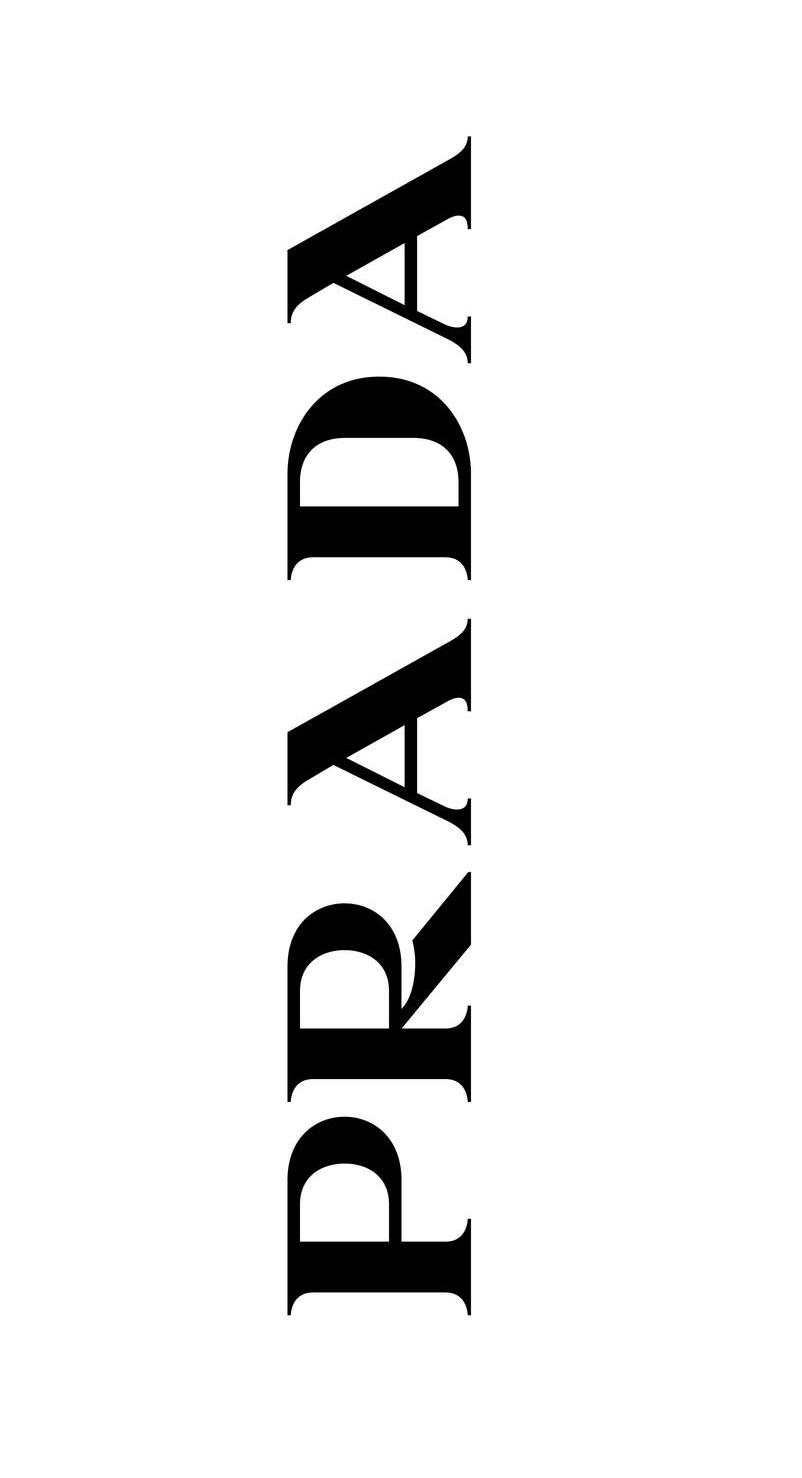


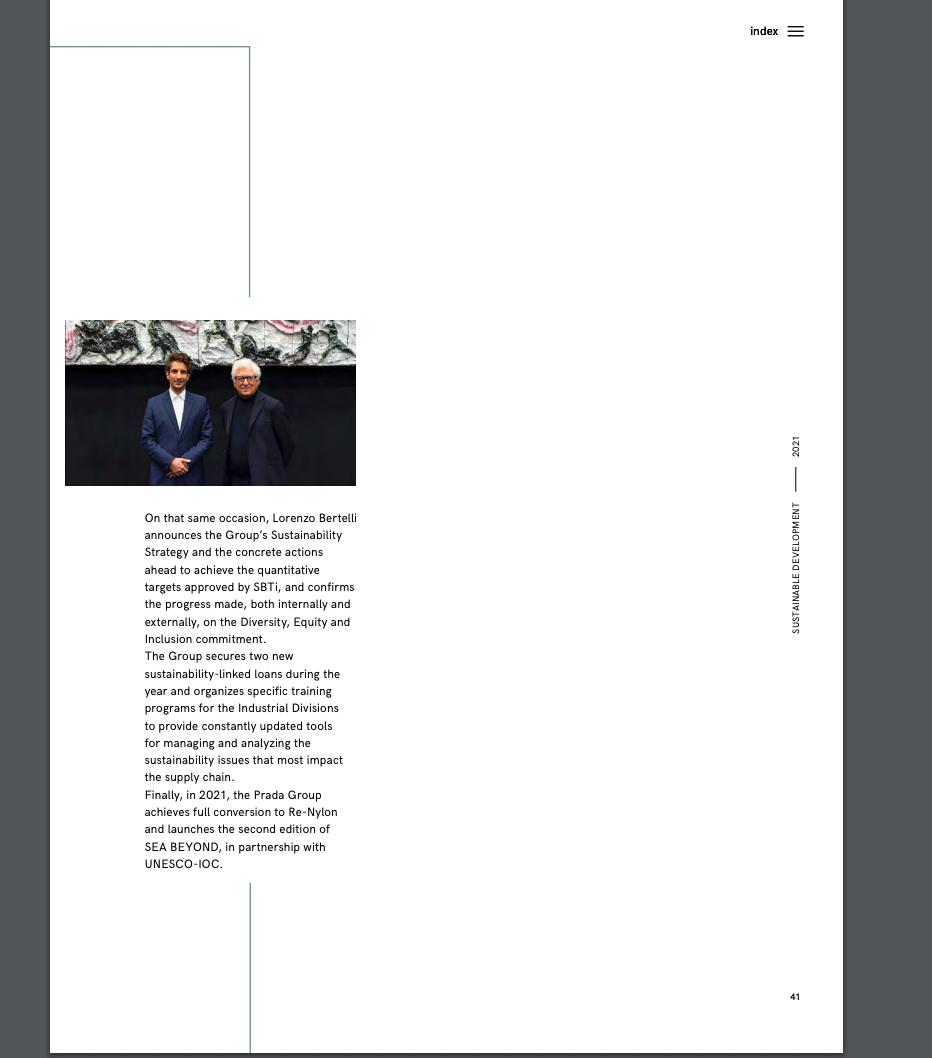
As of 2019, Prada Group's commitments to sustainability were bundled together in the final form of a Sustainability Policy. These commitments run through three key policy priority areas: Planet (environment), People and culture. 'These areas were specifically picked because the group is sure to bring preeminent contribution in terms of returning value to its own industry.'
To put into practice the policy, a Sustainable Strategy was designed, aiming to elaborate the medium-long term objectives. It will serve as the foundation for the formalisation of quantifiable targets that will direct future sustainability-related actions. The essential idea throughout the whole sustainable development is the protection of the groups identity and reputation.

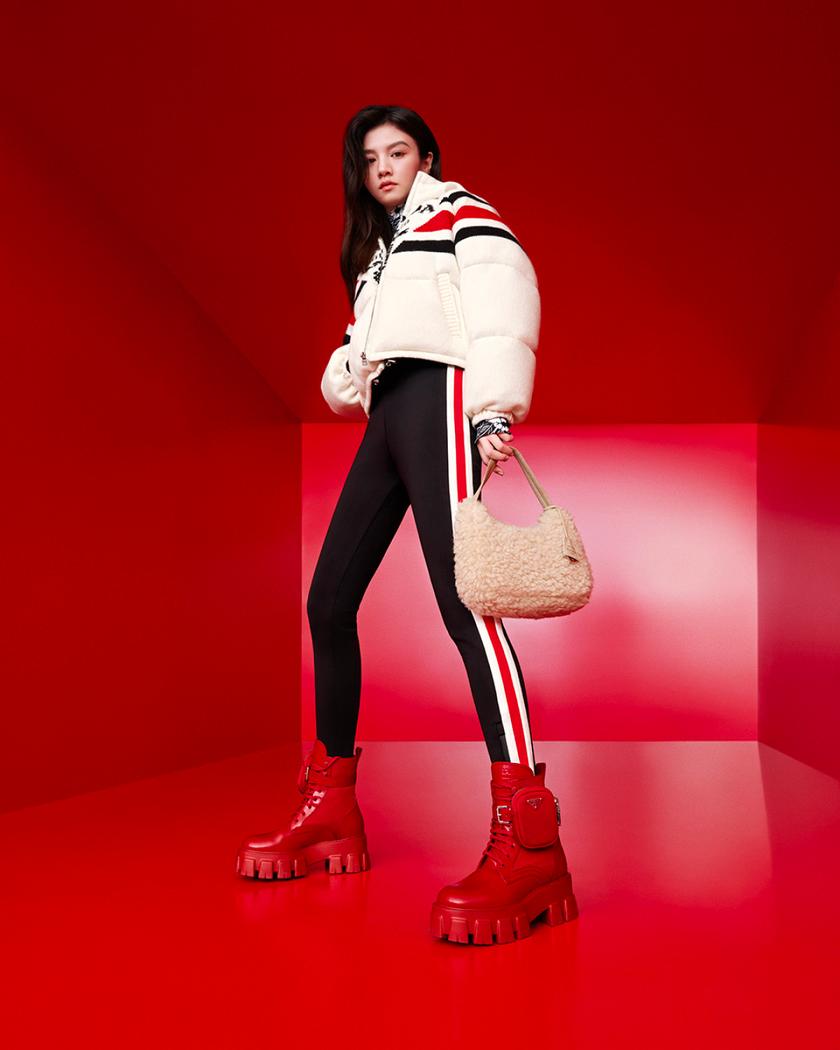
The Prada Group was the first in the luxury world to sign a 'Sustainability Linked Loans'. They singed 2 loans in 2021 with UniCredit and Crédit Agricole Group. KPI's that are put in place within these loan contracts:
The regeneration and reconnection of product waste
The Increasing of the share of selfproduced energy
Additionally to the loans, the Group invested more than 80 million since 2019, focussing on strong vertical integration of the supply chain and insourcing. This will lead to having way more control over raw materials and finished products. According to their own words, a supplier needs to go through a strict selection process, ensuring high standards in technical and economical as ethical reliability. As visible in the charts, they are deeply rooted in Italy.


In the meanings of putting product quality and costumer health and safety central, Prada Group published in 2014 their own Restricted Substances List (RSL), to set limits on the use of certain chemicals in its production. In 2016, they aligned this list with 'Guidelines on eco-toxicological requirements for clothing, leather goods, footwear and accessories', ratified by National Chamber of Italian Fashion set up guidelines. This document sums up and divides chemicals per danger they cause and is an overview of benchmarks of chemical families in products. The implementation can be done in 2 ways: proactive and advanced.
Prada Group declared in 2021 to have reached 100% of the purchase volumes being carried out according to the "proactive" level. Which means: "to consider the limits for the presence of residues of substances in articles, starting from the most restrictive international legislative requirements, to which voluntary parameters are added, which include or go beyond, those of the law'.
Whilst Advanced means "to consider advanced sector requirements as objectives to be achieved, with a view to continuous improvement, by researching and implementing the best available technologies. These objectives can be pursued through a continuous process of training and collaboration with the entire supply chain and will be reviewed at least annually (unless mandatory legislative changes are made)."
In order to make these guidelines are legit and to make sure they're being set up correctly, The Prada Group has to make sure all analyses are being carried out in ISO 17025 accredited laboratories.


The goal is to be able to identify areas of improvement on reducing its greenhouse gas emissions. The targets the Group establishes, are consistent with a maximum increase of A.5°C in earth's temperature. Two examples of targets are:
Reduce absolute Scope 1 & 2 GHG by 29,4% by 2026 (2019 as baseline)
Scope 1: directly related to its activities, like consumption of natural gas, used during production operations, company fleet and air conditioning.
Scope 2: also directly related to its activities; emissions caused by processes on manufacturing sites, logistic centers, offices and stores all over the world.
Since 214, Prada has been investing in energy efficiency with the aim to reduce its energy consumption and Greenhouse Gases (GHG) emission. They set up different projects like relamping all the store lighting, globally using Green energy supplied by renewable sources with Guarantees of Origin certification, etc. In 2020, they decided to measure finally their inventory in GHG emissions. This was divided in 3 scopes: C L I M A T E S T R A T E G Y
Scope 3: emissions which main sources are indirectly related, caused by purchase of goods and services (71%) and related to inbound and outbound logistics (18%) and employee commuting (5%)
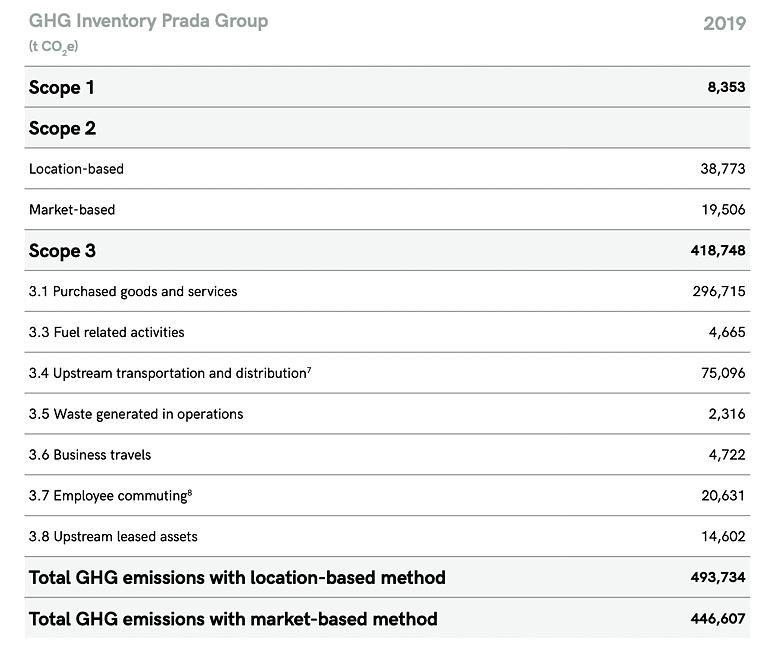

Reduce absolute of Scope 3 GHG emissions by 42% by 2029 (2019 as baseline)


Carbon Disclosure Project, "is a notfor-profit charity that runs the global disclosure system for investors, companies, cities, states and regions to manage their environmental impacts. Over the past 20 years they have created a system that has resulted in unparalleled engagement on environmental issues worldwide. With their campaign in 2021 received unprecedented levels of investor support, with a 56% increase in the number of investors asking corporate environmental disclosure since 2020. Prada was requested to provide data on topics related to water security, forestry, or climate change. Results of investigations on Prada's impact over the past years, resulted in catastrophic scores. Surprisingly In their own sustainability report, they only mention briefly the B- from 2021.

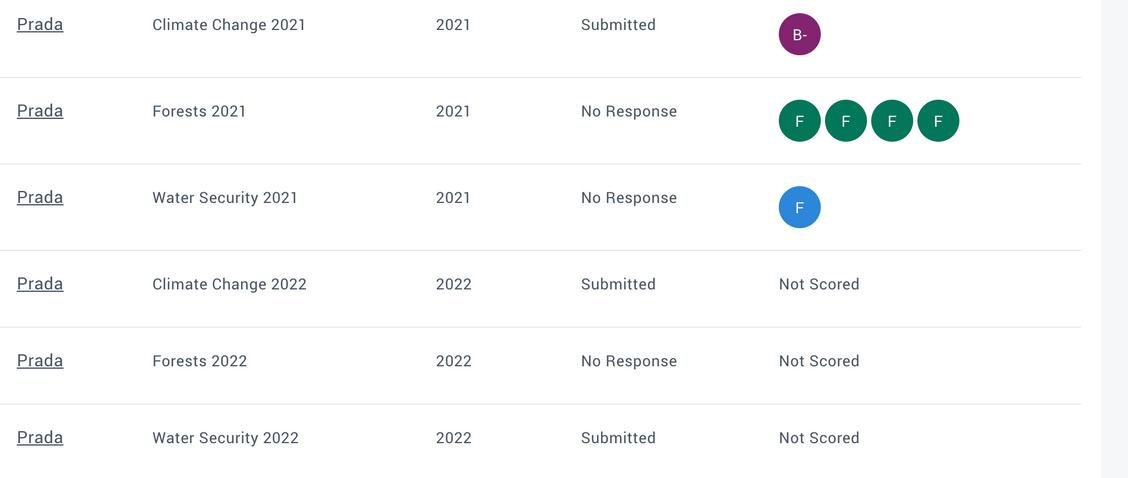
Water management, is a brand new topic to The Prada Group's annual CSR report. This kind of management concerns water consumption and water pollution relation to both raw materials and industrial processing. In the 2021 report, the Group mentions that its water consumption is mainly related to sanitary services and irrigation of green areas on production sites. They only talk about 2 places: French Tannerie (leather) and production facility in Torgiano (knitwear). No mention of all the other 22 entrusted manufacturing facilities located in Europe (19 of them in Italy) and to a network of external producers. In lack of statistical evidence of the years before: only 2O2O's and 2021's water with-drawl is available. There's clearly no evidence of water reduction nor its initiatives.

The materials used by Prada in the manufacturing process consist of :
Primary materials : leather, fabrics, yarns and ancillary materials
Semi-finished products: soles, heels, zippers, buttons, threads, ribbons, buckles, claps and name plates.
During the pandemic, 21 factories were closed and so the numbers of 2020 went down. In comparison, 2021 the purchases of the raw materials covered 83% of the economical value of all purchases including accessories & semi-finished products.
In the 2020 report, The Group discloses it's exactly the raw products that have the highest GHG emissions, leather counts for 93%, wool for 2%, nylon 0.9% and cotton 0.8%.
When looking at the GHG emissions from transport by type of source, raw materials are for 90% transported by plane, as we know, a big polluting form of transportation.
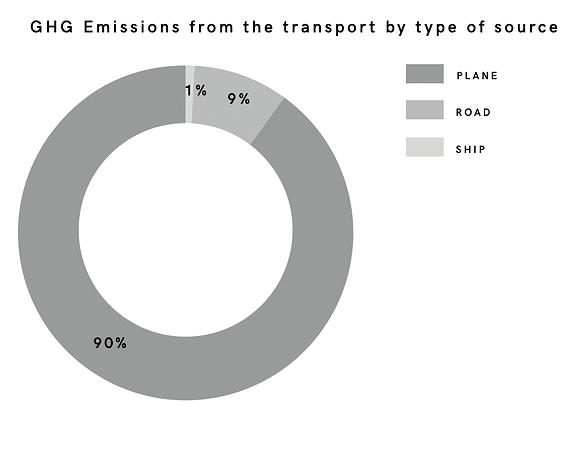
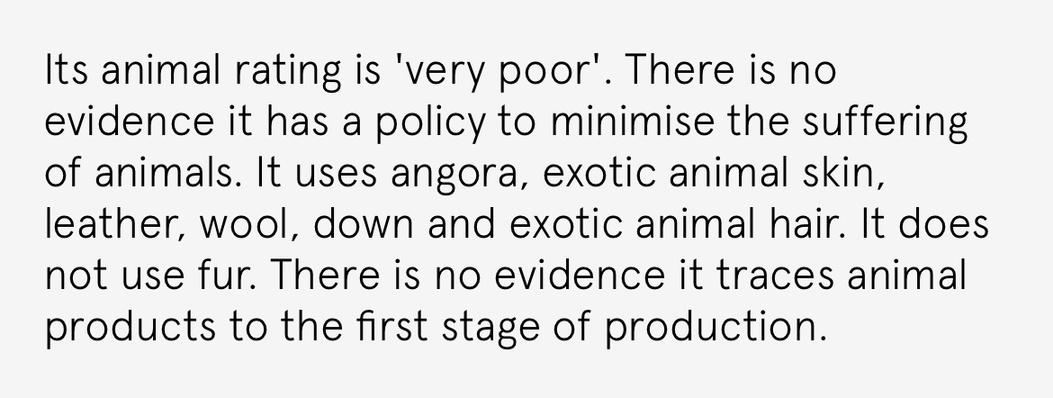

The leather used by the Prada Group these days are for footwear, bags and accessories. In 2021 90% of the leather has Italian origin, 6% from suppliers based in other parts of the European Union, and the rest, 4% from outside the EU.
A target regarding leather procurement, which is to have all their leather certified by Leather Working Group (LWG) by 2023.
L EATHERUntil now, this is only the case for 52% of the tanneries employed by Prada Group.
The Leather Working Group, is a non-profit, global multi-stakeholder community committed to building a sustainable future with responsible leather.
Leather is known today to not being sustainable because of its chrome-tanning facility that wastes nearly 15,000 gallons of water and produces up to 2,200 pounds of “solid waste” (e.g., hair, flesh, and trimmings) for every ton of hides that it processes.
On the app 'Good On You' Prada got the score 'Not Good Enough' furthermore, on animal rating they score very poor. Which is understandable first of all, when knowing only half of the tanneries for example, are certified with by LWG, who investigate the whole supply chain and make sure it's done in a durable way, meaning; without animal cruelty. These numbers are shocking since the brand has been in the leather industry for over 100 years. And secondly, because there's no disclosure on how and where the animals come from specifically.
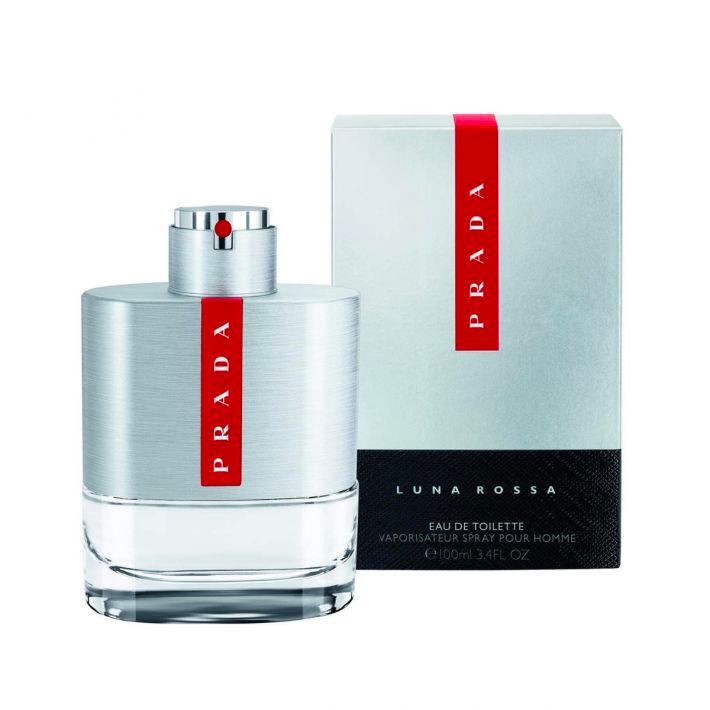
The Prada Group has set up a system to manage the internal cycle of waste collection, temporary storage, transport and disposal. By analysing the results of the system, they aim to optimise the production cycles, thereby reducing waste production and increasing the production of waste that gets recycled. In 2021, the Prada Group had produced 2.210 tons of industrial waste, mainly consistent of paper, cardboard, packaging materials, textile and leather waste. This was 41% decrease in comparison to 2019. The waste that is hazardous (dangerous) which represents 1% of all waste. This represents 22 tons, still, which is a lot. As Good On You explained, it's not mentioned by the Group how they will eliminate those hazardous chemicals.
The Group used 4.691 tons of paper for packaging globally. 89% of the total packaging consumption consists of paper that's certified by Forest Stewardship Council (FSC) and recycled paper.
Only in 2020 they stared aiming to also in the clothing department converting to packaging that's 100% plastics into recycled or regenerated plastic. Again, we don't get a clear target, no further detailed explanation on how the paper and plastic recycling happens.

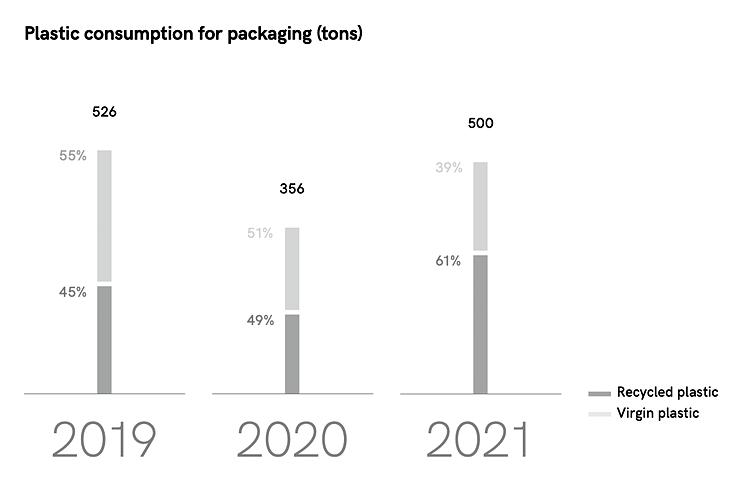
So what sustainable changes do they implement? There's the Prada Re-nylon project, an initiative of the Prada Group emerged from reflection on todays growing awareness about environmental protection. The transformation of one of Prada's emblems, was done in collaboration with the Aquafil Group. They have been a pioneer of the circular economy and a landmark in terms of quality and product innovation for Italy and the globe, since 1965.
Aquafil flagship's product , ECONYL® nylon, the one used by Prada for their Re-Nylon collections, revolutionises the world of synthetic fibers through a closed-loop model. ECONY® is regenerated yarn which has the same qualitative characteristics as traditional nylon, with a lower environmental footprint and infinite number of times without any loss in quality. It's made from nylon waste (that uses a lot of oil during processing), that could be abandoned fishing nets or textile production scraps.
Aquafil has a strong policy framework, standards, and guidelines in place that guarantee it operates business responsibly and complies with ESG responsibilities listed in the ECO PLEDGE Trademark and provides a solid commercial performance. Additionally, it maintains some thirdparty certificates indicating the Group's compliance with the strictest standards for the environment, society, and quality. Implementing this in Prada's products, will have greater impact for the brands sustainable actions.



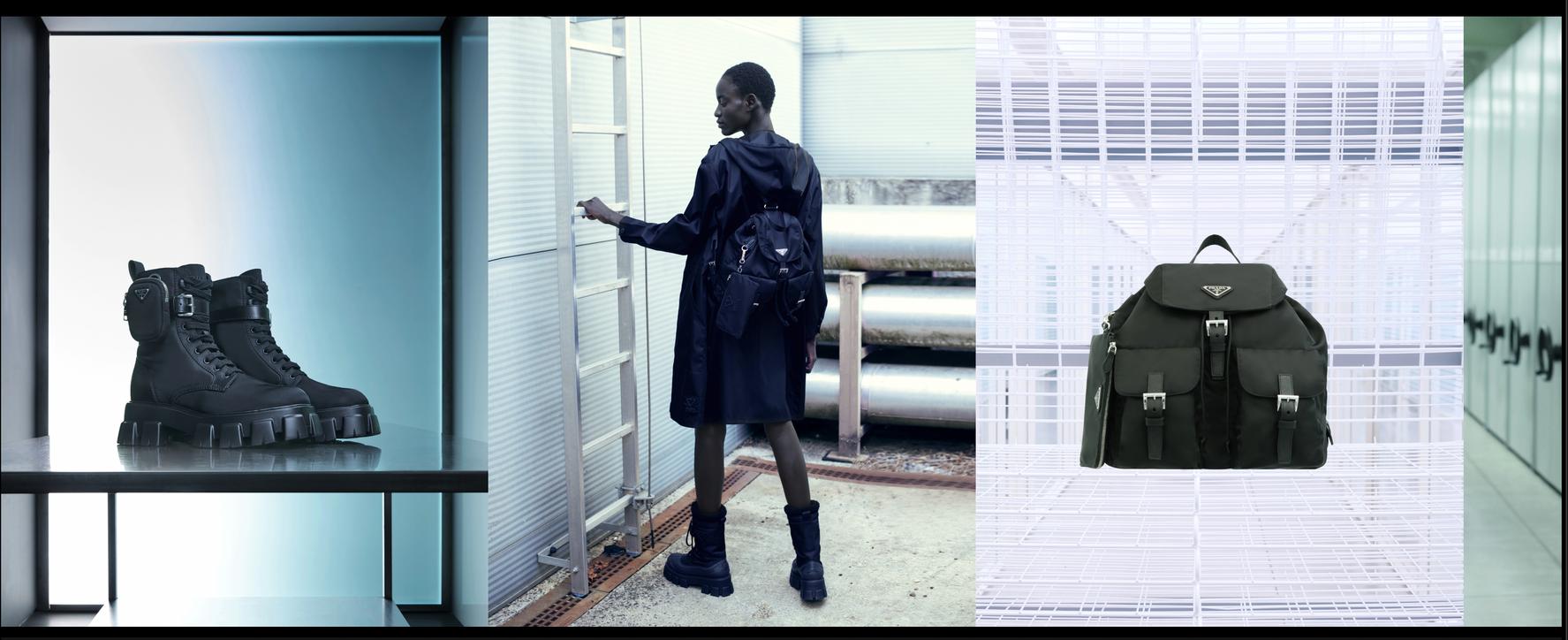





Since the launch of the SS20 woman's collection, Prada stopped using fur, as part of its collaboration with the Fur Free Alliance (FFA), a coalition of more than 50 animal protection organisations from over 40 countries.
Fur is reported to make up barely 0.1% of the materials used in manufacturing, in contrast to leather, which, together with nylon, is one of the key materials in Prada, thus its creativity with fur is not the same as that with nylon. Furthermore, the fabrics used to replace the fur, have not been specified, nor been certified as sustainable.


The Prada Group signed The Sustainability Pact in 2019. The targets of the pact, which was signed by 32 fashion companies are
Net-zero carbon emissions by 2050
100% renewable energy by 2030
Eliminate single-use plastic by 2030
Support innovations and methods for removing micro-fibre pollution, and regenerate agricultural programs. Restore biodiversity: to restore natural ecosystems and protect species; Protect the ocean: by reducing the fashion industry’s negative impact on the ocean through practical initiatives.
This mission was given to Kering CEO, François-Henri Pinault by French President, Emmanuel Macron, the Fashion Pact was presented to Heads of State at the G7 Summit in Biarritz. Prada has committed to achieving all of these objectives by signing it. But the agreement is not binding and suppliers are not really under the authority of brands. Instead of something that results in actual change, this remark can be another one that is sustainable. However, it is undoubtedly a statement that Prada supports the 30% of the industry that wants to make a difference.
The Prada Group states in their Sustainability report of 2021 that they 'see diversity as an essential element of social sustainability.'
But looking at the numbers, some things were made clear. Of its whole workforce, 39% is located in Italy (represents 84% of raw material manufarcure), 23% in Asia-Pacific and the rest, 20% in Europe. Whithin this workforce, women represent the majority on every level of the Group (operators, staff & professionals, topsenior and middle management, retail, etc.). What is dissapointing is that looking at the wages, there's a clear pay gap, for which no response is given, it simply just exists.


Another issue is that Prada has a history of racist imagery; in 2018, the brand faced harsh criticism for its "Pradamalia" miniatures that resembled blackface. Following this, Prada and the New York City Commission on Human Rights reached an agreement under which Prada must appoint a Diversity and Inclusion Officer and require all employees to participate in sensitivity and racial equity training before Prada's designs are sold, advertised, or otherwise promoted in the United States. When speaking with Prada, civil rights attorney Chinyere Ezie came to the conclusion that "there were no black staff working at Prada headquarters at all (by the end of 2018)" after bringing up the company's racial issues. In 2019, Prada established the Diversity and Inclusion Advisory Council, something they declared they wanted to do before the Commission on Human Rights got involved. This council must last for six years, and Prada must report to the Commission on Human Rights every six months for two years.

Sea Beyond, is an educational program, actif in several schools, that's devoted to the preservation of the sea & ocean literacy. The purpose is to educate in a more responsible and conscious way towards the planet and its water resources. The project is supported by a percentage of the sales of the Prada Re-Nylon collection.

Not to mention that the project is set up according to United Nations 2030 agenda with the 17 sustainable Development Gaols. The professors of the schools involved are part of the UNESCO network and participate in webinars led by ocean literacy experts, during which those professors receive guidance how to develop the educational module dedicated to ocean preservation.

To come to a final conclusion, Prada is not a sustainable brand, nor is The Prada group. However, they have made plans which show a commitment to becoming one, like becoming part of the Leather Working Group, the Re-Nylon project and educational UNESCO-program Sea Beyond.
Nevertheless, while reading the Sustainability Reports, they want to get perceived as sustainable, talking about their implications in several sustainable topics. It's after reading between the lines and gathering statistical information that proves that Prada's general manufacture and corporate actions are not done in a sustainable way, and they still have a long way to go. The same result is presented in the Fashion Transparency Index 2022 edition, where the brand scores low to mediocre on all topics like : governance, policies & commitments, transparency, traceability, etc. Prada has not been creating sustainable collections, with the exception to the re-nylon series. One could go into more depth regarding each collection's fabrics and manufacturing processes, but we'll just sum it up by saying that their promises haven't yet manifested themselves in the quality of their clothing. This is unfortunate because there has never been a time when sustainable collections have seen greater innovation, research, and creativity. I think it would be a good next step for Prada to work with innovators in this field.
Additionally, the plans they put in place, hopefully bring rapid change in their manufacture and production processes and diversity and inclusivity. It's just sad that on the last part, the Commissions on Human Rights had to come in between, instead of Prada using their common sense from the beginning.
The essential idea is that Prada wants to be held responsible for these pledges; by bringing up sustainability and getting involved with it, they are opening themselves up to criticism and increasing presence from the public. This is also demonstrated in their third annual conference, "Shaping a Sustainable Future Society," which explores how Prada could create a better future. We expect to see even more significant changes in the future by keeping an eye on Prada's objectives and participating in the discourse around sustainability.
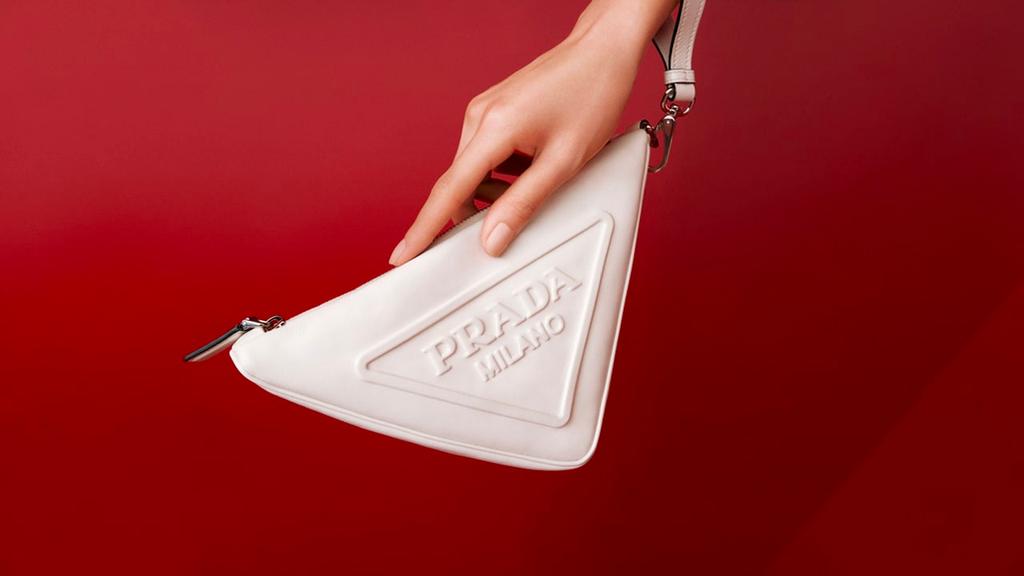

https://www.pradagroup.com/en.html
https://www.pradagroup.com/en/sustainability/prada-impact/impact.html
https://www.fashionintime.org/prada/ https://www.youtube.com/watch?v=FmSndM1lmC0
https://wwd.com/sustainability/social-impact/prada-lorenzo-bertelli-sustainability-1234788824/ https://luxiders.com/evaluating-pradas-sustainable-commitments/ https://www.pradagroup.com/en/sustainability/prada-impact/sustainability-strategy.html
https://www.lampoonmagazine.com/article/2021/05/01/raf-simons-prada-ready-to-wear/ https://www.cameramoda.it/media/documents/roundtable/lineeguida/linee_guida_en_1.pdf
https://www.pradagroup.com/content/dam/pradagroup/documents/Responsabilita_sociale/2022/eSustainability%20Report%202021.pdf
https://www.pradagroup.com/content/dam/pradagroup/documents/Responsabilita_sociale/2021/e-2020-SocialResponsibility-Report.pdf
https://www.pradagroup.com/content/dam/pradagroup/documents/Responsabilita_sociale/2021/e-2020-SocialResponsibility-Report.pdf
https://www.cdp.net/en/responses?
page=2&per_page=20&queries%5Bname%5D=Prada&sort_by=project_year&sort_dir=asc https://www.cdp.net/fr/articles/media/a-record-168-investors-with-us17-trillion-of-assets-urge-1300firms-to-disclose-environmental-data https://www.cdp.net/en
https://www.leatherworkinggroup.com/ https://www.aquafil.com/
https://www.aquafil.com/assets/uploads/ENG_RS_Aquafil_2021.pdf
https://luxiders.com/evaluating-pradas-sustainable-commitments/ https://www.fashionrevolution.org/about/transparency/
https://textileexchange.org/featured/aquafil-2017/?gclid=CjwKCAjw8JKbBhBYEiwAs3sxN7thWDdmDJPJEDXZOovCGGllN4LVq6zi6K-UaAGvP6zBNvjYzj8dxoCoCUQAvD_BwE